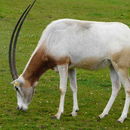en
names in breadcrumbs


Several physiological abilities unique to desert oryxes enable them to live nomadic lifestyles in near-desert environments. Under conditions of water stress these oryxes can raise their body temperature up to 116 degrees F (46.6 C). With functioning metabolism at these high temperatures, less water is needed for evaporation in order to help conduct heat away from the body. This reduced evaporation of bodily fluids helps these oryxes go long periods without water. In times of ample supply, oryxes can also use fluid loss through urination and feces, to lower their body temperatures below 97 F (36 C) at night, thus allowing them more time before maximum body temperature is reached the following day.
Another anatomical adaptation allows the oryx to tolerate high temperatures that would be lethal to most mammals. They have a network of fine blood vessels that carry blood from the heart to the brain. These blood vessels travel close to the nasal passage, allowing cooling of up to five degrees F of the blood before it is pumped to the brain, one of the most heat sensitive organs of the body.
Perception Channels: tactile ; chemical
Though the Scimitar oryx's range has been greatly reduced, especially in the north, their numbers have stayed relatively high thanks to the large numbers living in captivity. Several large game preserves, mainly in Texas, have instigated successful programs for breeding the Scimitar-horned oryx. However, its habitat is being destroyed and reintroduction of large populations may prove difficult.
US Federal List: endangered
CITES: appendix i
IUCN Red List of Threatened Species: extinct in the wild
This oryx was used as a food source in the past, but now its most valuable contribution is probably its place in ecotourism. Both Africa and the United States are profiting greatly from the recent rise in this new form of tourism.
The Scimitar-horned oryx is herbivorous, feeding on annual grasses, herbs, juicy roots, buds, and when water is scarce, fruits and vegetables. Like most inhabitants of arid environments it is subject to unpredictable and variable amounts of precipitation. Because of their great nomadic ability, the Scimitar-horned oryx will travel many miles in search of new new green grass which sprouts up quickly after sudden down pours. Though they tend to stay in small groups of about 40, when food is scarce and concentrated they can form herds of more than a hundrend.
The Scimitar-horned oryx is found in the desert to semidesert region of Africa known as the "Great Steppe." This area is a strip of arid grassland extending from Senegal to central Sudan, which borders the southern edge of the Sahara Desert.
Biogeographic Regions: ethiopian (Native )
The Scimitar-horned oryx is found in barren steppes of desert to semidesert environments.
Terrestrial Biomes: desert or dune ; chaparral
Average lifespan
Status: captivity: 27.5 years.
The Scimitar-horned oryx, like other oryxes, has a black and and white face mask. However, in this species the black tends to fade to a brownish color. Their basic color is white with rusty brown necks and chests. Soms specimens have brown bands on their flanks along with a rusty brown spot outlined on the thigh. Like all orxyes, calves are born with yellow coats and lack distinguishing marks which appear later in life. The Scimitar-horned oryx is average in size compared to the larger East African oryx or the smaller Arabian oryx. Average length is 5.5 ft (1.7 m) with a shoulder height of about 3.8 ft (1.2 m)and an average weight of 148 lbs . It is the only oryx whose horns curve backwards. The horns average about 40 inches (1 m), but lengths of 50 inches (1.2 m) or more have been recorded. Both sexes have horns and, like other oryxes, the female's tend to be more slender.
Average mass: 200 kg.
Other Physical Features: endothermic ; bilateral symmetry
Average mass: 177500 g.
Courting is done through the means of a mating circle. During this ritual, the male and female stand parallel to one another facing opposite directions. They then circle around one another until the cow allows the male to mount from behind. HOwever, if the female is not ready to mate, she can run away and circle in the reverse direction. Once the female oryx is impregnated, gestation lasts between 8 and 8.5 months. There is only one calf per birth, weighing an average of 20 to 33 lbs (9 to 15 kg).
Range number of offspring: 1 (low) .
Average number of offspring: 1.
Range gestation period: 8.07 to 8.53 months.
Key Reproductive Features: gonochoric/gonochoristic/dioecious (sexes separate); sexual
Average birth mass: 10317 g.
Average number of offspring: 1.
Average age at sexual or reproductive maturity (female)
Sex: female: 639 days.
Parental Investment: post-independence association with parents